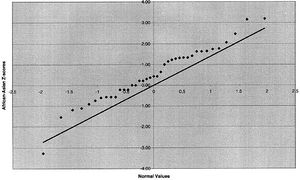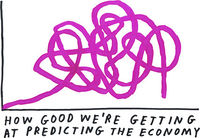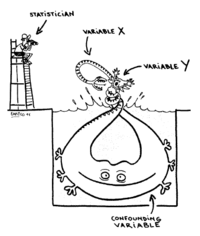Chance News 95: Difference between revisions
mNo edit summary |
|||
| Line 119: | Line 119: | ||
What do you make of the last sentence? Is this a Forsooth? | What do you make of the last sentence? Is this a Forsooth? | ||
==Talk and | ==Talk and interview by ''Proofiness'' author== | ||
Charles Seife is the acclaimed author of ''Proofiness: The Dark Arts of Mathematical Deception''. A Chance News review may be found [http://test.causeweb.org/wiki/chance/index.php/Chance_News_67#Proofiness here]. | Charles Seife is the acclaimed author of ''Proofiness: The Dark Arts of Mathematical Deception''. A Chance News review may be found [http://test.causeweb.org/wiki/chance/index.php/Chance_News_67#Proofiness here]. | ||
Revision as of 20:58, 7 September 2013
Quotations
“It is worth dwelling for a moment on Egon [son of Karl] Pearson’s first-year lecture course …. [H]e was an inspirational teacher …. What was the reason for his success? [H]e was not a teacher who ladled out cookery-book recipes; rather he always seemed in his lectures to be working through and exploring problems with the class. He would wander down enticing dead-ends, but return to seek alternatives again and again until a satisfactory approach had been established. The result was that students acquired a questioning approach, not a compartmentalized approach whereby one problem was allocated to a 2 x 2 table, the next to multiple linear regression, etc.”
(1994 presidential address to the RSS)
Submitted by Margaret Cibes
“In my own field of flood risks, a talented statistician declared: ‘It is also true that for extremely rare events, correct uncertainty estimates may lead us to conclude that we know virtually nothing. This is not such a bad thing. If we really know nothing we should say so!’”
Submitted by Margaret Cibes
Forsooth

from “Ethnicity and Human Genetic Linkage Maps”, American Journal of Human Genetics, February 2005

The New York Times, August 24, 2013

Submitted by Margaret Cibes and James Greenwood
Weeding wedding invitation lists
“GUESTimation: Breaking the deadlock on wedding guest lists”
by Damjan Vukcevic, Significance, August 2013
Winner of the second annual Young Writers Competition, this article describes the process the author used to narrow his initial wedding guest list down to a number that his venue could accommodate. The process included grouping potential invitees (e.g., families), ranking them for their probabilities of attending if invited (to Australia), and using a probability distribution of the number of attendees to get a confidence interval of attendees. He also discusses his independence assumption and the consequence of using or not using it.
Submitted by Margaret Cibes
Civil rights and Simpson's paradox
Mary Parker sent this example of Simpson's Paradox to the Isolated Statisticians list:
Were Republicans really the party of civil rights in the 1960s?
by Harry J. Enten, Guardian, 28 August 2013
The 50th anniversary of the March on Washington and Martin Luther King's famous "I have a dream speech" have been commemorated in much recent news coverage. In light of some Republican claims that their record on civil rights compares favorably to Democrats, the Guardian takes a statistical look at the voting record on the landmark Civil RIghts Act of 1964.
The article presents 3 tables, which are reproduced below. The first breaks out the vote by party in the House of Representatives and the Senate, indicating that the bill had greater support among Republicans.
1964 Civil Rights Act Senate Version Ayes Democrats Republicans House 153 of 244 (63%) 136 of 171 (80%) Senate 46 of 67 (69%) 27 of 33 (82%)
The second table takes into account the history of the Civil War, separating out the 11 southern states that formed the Confederacy (note the remaining 39 states are classified as "Union", but of course not all of these current states existed in the 1860s).
1964 Civil Rights Act Senate Version Ayes Union Confederacy House 281 of 313 (90%) 8 of 102 (8%) Senate 72 of 78 (92%) 1 of 22 (5%)
Observing that political party and geography both matter, the Guardian's third table accounts for both:
1964 Civil Rights Act Senate Version Ayes Dem/Union Rep/Union Dem/Confed Rep/Confed House 145 of 152 (95%) 137 of 161 (85%) 8 of 91 (9%) 0 of 11 (0%) Senate 45 of 46 (98%) 27 of 32 (84%) 1 of 21 (5%) 0 of 1 (0%)
This gives an example of Simpson's Paradox. In both the north and the south, the bill had stronger support among Democrats than Republicans. However, aggregating over region leads to the first table, which reverses the direction of the association. The explanation is that a larger proportion of Democrats came from the south (they outnumbered Republicans 91 to 11 in the House and 21 to 1 in the Senate), where support for the Civil Rights Act was weaker.
[Note. In the original Guardian article, the third table gives the Dem/Union count in the House as 144, which leaves the Aye total for Democrats one vote short of the first table. Nick Horton alertly noticed this and wrote to the author, who subsequently identified the missing vote as a Pennsylvania Democrat whose party affiliation was listed as "unknown" in one of the voting databases. Thanks to Nick for communicating the correction to the Isolated Statisticians list.]
Curious quotation on correlation
Margaret Cibes sent the following passage from The Big Short: Inside the Doomsday Machine, by Michael Lewis (Norton, 2011):
At issue was how highly correlated the prices of various subprime mortgage bonds inside a CDO might be. Possible answers ranged from zero percent (their prices had nothing to do with each other) to 100 percent (their prices moved in lockstep with each other). Moody’s and Standard Poor’s judged the pools of triple-B-rated bonds to have a correlation of around 30 percent, which did not mean anything like what it sounds. It does not mean, for example, that if one bond goes bad, there is a 30 percent chance that the others will go bad too. It means that if one bond goes bad, the others experience very little decline at all. [pp. 207-208, emphasis added]
Discussion
What do you make of the last sentence? Is this a Forsooth?
Talk and interview by Proofiness author
Charles Seife is the acclaimed author of Proofiness: The Dark Arts of Mathematical Deception. A Chance News review may be found here.
Here is a link to a video of his hour-long lecture given at Google’s New York office. The title of his presentation is “Context is Everything-More About the Dark Arts of Mathematical Deception.”
This web site also refers one to a 26 minute New Zealand radio interview which is entitled, “Numbers Don’t Lie, But People Do.”
Submitted by Paul Alper